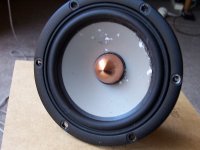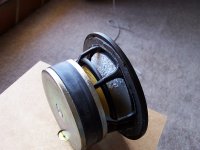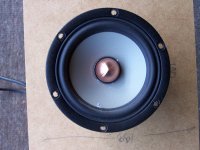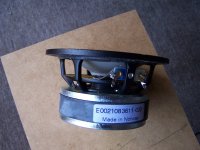About five years ago I bought some SEAS Excel drivers (W12CY001). I put them in a pair of loudspeakers I built for a friend. Recently he informed me that the drivers had developed corrosion on the magnesium cones. I have attached some images of the drivers. One is much worse. The speakers were located in an old and somewhat damp house, but not excessively so. I assume that the protective coating on the magnesium cones was not applied properly.
I contacted SEAS about it and this was the reply:
"Hi John,
We are glad to hear that you are happy with the sound and the speakers.
Unfortunately, there is nothing you can do about the corrosion I’m afraid. We treat the magnesium to make sure that they don’t, but this does not work in warm and humid areas of the world.
It is difficult for us to find a solution for this as the climate here is so different, and it usually takes 3-5 years before the corrosion starts. However, we can assure you that this is purely cosmetic, and has no effect on the sound quality.
Med vennlig hilsen / Kind regards
SEAS Fabrikker AS"
I did reply to this that, if corrosion will occur in damp climates, then the ethical thing to do would be to add a warning on their website about magnesium drivers. I did not receive a reply.
Regards,
John
I contacted SEAS about it and this was the reply:
"Hi John,
We are glad to hear that you are happy with the sound and the speakers.
Unfortunately, there is nothing you can do about the corrosion I’m afraid. We treat the magnesium to make sure that they don’t, but this does not work in warm and humid areas of the world.
It is difficult for us to find a solution for this as the climate here is so different, and it usually takes 3-5 years before the corrosion starts. However, we can assure you that this is purely cosmetic, and has no effect on the sound quality.
Med vennlig hilsen / Kind regards
SEAS Fabrikker AS"
I did reply to this that, if corrosion will occur in damp climates, then the ethical thing to do would be to add a warning on their website about magnesium drivers. I did not receive a reply.
Regards,
John
Attachments
This is very common in warm coastal areas in Australia. I've had this corrosion on Vifa drivers with magnesium baskets and nothing could be done to stop or fix it. On the second picture, I imagine that the corrosion is on the top when it was in the speaker.
I live a few kilometres away from the coast and a kilometre from the lake but the air can still be salt laden. On warm humid days a good air conditioner can dehumidify the room and provide a better environment.
Put some grilles on the speaker and ignore it.
I live a few kilometres away from the coast and a kilometre from the lake but the air can still be salt laden. On warm humid days a good air conditioner can dehumidify the room and provide a better environment.
Put some grilles on the speaker and ignore it.
The speakers were located in an old and somewhat damp house
Sydney has the enemy of any material that can corrode, high summer temperatures and high humidity, more so with a damp house.
So I struck a little Google Gold! I searched for woofer corrosion and found an interesting thread. Bottom line was that the formaldehyde off-gassing inside the cabinets from the MDF was responsible for the crystals forming. More here:
Driver durability in hot & humid SG
Driver durability in hot & humid SG
I have W18's in the home since 2001 that are brand new looking, and seeing these pics are quite disappointing. For the money that SEAS gets these days for their mag speakers, they should not be doing this whatsoever. I'm in agreement with OP that SEAS and all Distributors should be providing a disclaimer regarding humid climates.
I did reply to this that, if corrosion will occur in damp climates, then the ethical thing to do would be to add a warning on their website about magnesium drivers. I did not receive a reply.
Regards,
John
You're absolutely right that a warning would have been more ethical but in a crazy world we live in, we all know what the prime directive is.
Excel Mg corrosion.
Good Googling!
That looks very plausible. The enclosures are made of mdf.They are sealed, and the corrosion appears worse on the inside.
Hmmm...
I'm still going to replace the drivers with the cheaper aluminium L12's, but I will seal the inside of the box.
There is a low formaldehyde mdf that I do use these days, but I can't recall what I used on these particular boxes.
Thank you for your research,
John
So I struck a little Google Gold! I searched for woofer corrosion and found an interesting thread. Bottom line was that the formaldehyde off-gassing inside the cabinets from the MDF was responsible for the crystals forming. More here:
Driver durability in hot & humid SG
Good Googling!
That looks very plausible. The enclosures are made of mdf.They are sealed, and the corrosion appears worse on the inside.
Hmmm...
I'm still going to replace the drivers with the cheaper aluminium L12's, but I will seal the inside of the box.
There is a low formaldehyde mdf that I do use these days, but I can't recall what I used on these particular boxes.
Thank you for your research,
John
Good Googling!
That looks very plausible. The enclosures are made of mdf.They are sealed, and the corrosion appears worse on the inside.
Hmmm...
I'm still going to replace the drivers with the cheaper aluminium L12's, but I will seal the inside of the box.
There is a low formaldehyde mdf that I do use these days, but I can't recall what I used on these particular boxes.
Thank you for your research,
John
The corroded baskets on the photos are made of aluminium... paper cones and plastic basket should be my choice.
Completely unacceptable. Seas know about it yet they dont provide any warning. The problem is obviously not just cosmetic. Thumbs down for Seas
+1 Drivers shouldn't require Ziebart.
Corrosion
I've just replaced the drivers with a L12s, and I realised i have used foam on the inner walls of the enclosure, about one inch thick that I got from an acoustic foam supplier. I wonder if the foam might release formaldehyde or something similar. Anyway, to be on the safe side, I have removed the foam and replaced it with the usual stuffing material.
John
I've just replaced the drivers with a L12s, and I realised i have used foam on the inner walls of the enclosure, about one inch thick that I got from an acoustic foam supplier. I wonder if the foam might release formaldehyde or something similar. Anyway, to be on the safe side, I have removed the foam and replaced it with the usual stuffing material.
John
- Home
- Loudspeakers
- Multi-Way
- Corrosion SEAS Magnesium Drivers




